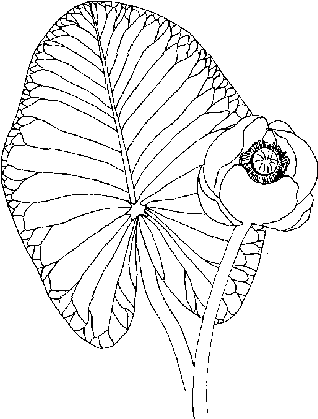Common Aquatic Plant Management Problems
Please note:
This information is intended for educational purposes only. References to commercial
products or trade names are made with the understanding that no discrimination is intended of
other products which may be available. Any herbicides recommended herein for the treatment
of aquatic vegetation have been registered by the Environmental Protection Agency for use
in the manner described. The registration and use of a particular product may change
therefore the information provided here may not remain current indefinitely. It is the
responsibility of the user to read and follow the manufacturer's label to prevent misuse
of the product.
Spadderdock

Scientific Name - Nuphar luteum
Common Name: Cow Lily / Yellow Pond Lily
Distribution and Habitat
Spadderdock is found in ponds and swamps throughout South Carolina but is most common in the coastal plain. This plant thrives in shallow water bodies, particularly those having substrates of organic mud or silt. While stands of spadderdock provide excellent habitat for fish and other aquatic life, extensive growths of this plant can seriously impede recreational use of a pond.
Description
Spadderdock is a rooted aquatic species possessing large, heart shaped leaves 8 to10 inches long and 5 to 8 inches wide supported by a long, fleshy stem. The leaves may be floating but more often grow well above the surface. Mature plants develop large rootstocks which give rise to numerous other plants. Throughout the summer months, spadderdock produces solitary, yellow flowers, 1 to 2 inches in diameter. The petals are clustered and do not open widely, giving the flower a ball-like appearance. Spadderdock is often mistaken for water lily but can easily be distinguished by its emergent leaves and absence of a showy, white flower common to water lily.
Recommended Control Methods
1. Granular 2,4-D
Active Ingredients: Ester of 2,4-Dichlorophenoxyacetic acid
Product Names: Aqua-Kleen; Riverdale; Weedtrine II
Approximate Cost: $1.90/lb.-$95.00/50lbs.
Application Rates: 100 -150 lbs./acre
(100 lbs./acre is equivalent to approximately 5 lbs./2000 sq. ft.)
Application Methods and Tips:
Granular 2,4-D is most effective against spadderdock during early growth, before the plants mature. The product should be applied in a broadcast fashion by the use of a fertilizer or seed spreader to ensure uniform coverage of the treatment area. Control will generally be confined to those areas where the herbicide is applied. Higher rates will be required in areas of dense growth, water greater than five feet deep or ponds with a short retention time (high volume turnover). Retreatment may be necessary to control mature stands of spadderdock. Care should be exercised when treating heavily vegetated ponds to prevent oxygen depletions due to decomposing plants. No more than one-third of the pond should be treated at any one time, allowing 14-21 days between applications. Certain water use restrictions apply to the use of this herbicide. Additional product directions and precautionary statements are listed on the herbicide container. READ AND FOLLOW THE HERBICIDE LABEL.
2. Rodeo:
Active Ingredient: Isopropylamine Salt of Glyphosate
Product Name: Rodeo
Approximate Cost: $110.00-$125.00/gallon
Appliction Rates: 6 pints/acre as a broadcast spray or ¾ percent solution
with hand-held sprayer
Mixing rates for ¾ percent spray solution:
| Desired Volume | Amount of Rodeo |
|---|---|
| 1 gallon | 1.0 ounce (2 tablespoons = 1 oz.) |
| 25 gallons | 1.50 quarts |
| 100 gallons | 3.00 quarts |
| *Manufacturer lists this product as a partial control agent | |
This product should be used with an approved surfactant at a rate of 1.0 - 1.5 quarts surfactant per 50 gallons of spray mix. Recommended surfactants include: Agri-Dex, Induce, LI-700, Liqua-Wet, Ortho Spreader 77, Passage, R-11, Super Spreader 200, Widespread
Application Methods and Tips:
Successful use of Rodeo is dependent on
contact of the herbicide with the plant foliage, therefore do not apply Rodeo to submerged
vegetation. Best results will be achieved during the summer or fall months when leaves are
emergent. Spray applications should be made to a spray-to-wet basis. Coverage should be
uniform and complete. Do not apply the product when rain is likely within 12 hours
post-treatment. Re-treatments may be necessary to achieve desired control. Care should be
exercised when treating ponds with dense growths of vegetation to prevent oxygen depletion
due to decomposing plants . No more than one-third of the pond should be treated at once,
allowing 14-21 day intervals between applications. Additional product directions and
precautionary statements are listed on the herbicide container.
READ AND FOLLOW THE HERBICIDE LABEL.
Other herbicides registered for the control of spadderdock:
- Sonar AS
- Sonar SP
Consult the fisheries biologist serving your county or more details concerning use of these products.
3. Sterile Grass Carp (White Amur)
Grass carp are not considered an effective alternative for the control of alligator weed.
The above information is available as a downloadable PDF - Spadderdock
